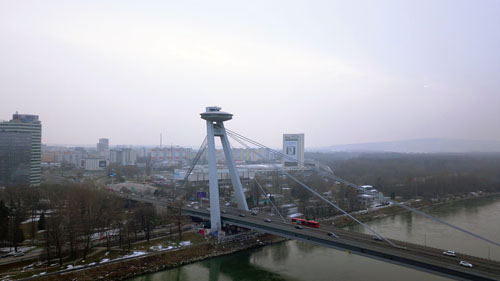 |
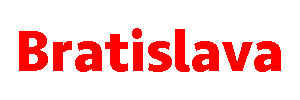 |
February 2018 |
Thursday 22 February 2018
Rotterdam – Wenen - Bratislava
We leave home for Rotterdam-the Hague airport by car at 4.15pm . We have
already checked in, so we only have to hand ove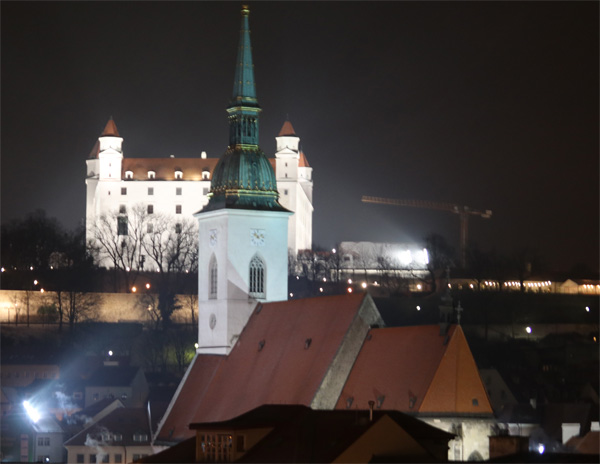 r
the suitcase. We eat something in the restaurant before the security checks
with a view on the departure platform. After dinner we go through the
security check and then have to walk to a temporary departure hall. There we
drink another cup of coffee and wait until we can board. At 6pm we can board
and the Transavia aircraft with
flight number HV5293 departs on time at 6.15pm and arrives in Vienna on
time, something before 8pm. We pick up the car at
Sixt. At Vienna airport it
is a longish walk to the car rental desk through tunnels, train station and
lifts, but it all works out. The car is at the 8th floor of the parking
building. We drive onto the highway in the direction of Bratislava. After
half an hour we are at the border with Slovakia and then it is another 14 km
before we arrive at the Radisson
Blu Carlton hotel, right in the center. We drive over the famous UFO
bridge and then we are there. We can park in the hotel's own underground car
park. The room is fine. We have a drink in the hotel bar and are immediately
confronted with the Slovak smoking policy. The non-smokers have to sit
outside the bar in the lobby, while the smokers can fill up the bar with
smoke!
r
the suitcase. We eat something in the restaurant before the security checks
with a view on the departure platform. After dinner we go through the
security check and then have to walk to a temporary departure hall. There we
drink another cup of coffee and wait until we can board. At 6pm we can board
and the Transavia aircraft with
flight number HV5293 departs on time at 6.15pm and arrives in Vienna on
time, something before 8pm. We pick up the car at
Sixt. At Vienna airport it
is a longish walk to the car rental desk through tunnels, train station and
lifts, but it all works out. The car is at the 8th floor of the parking
building. We drive onto the highway in the direction of Bratislava. After
half an hour we are at the border with Slovakia and then it is another 14 km
before we arrive at the Radisson
Blu Carlton hotel, right in the center. We drive over the famous UFO
bridge and then we are there. We can park in the hotel's own underground car
park. The room is fine. We have a drink in the hotel bar and are immediately
confronted with the Slovak smoking policy. The non-smokers have to sit
outside the bar in the lobby, while the smokers can fill up the bar with
smoke!
Weather: in Vienna -1⁰C and light snow.
Friday 23 February 2018
We get up around 7.30 and have breakfast at the hotel. The breakfast is
well presented and has a very broad range of items. After breakfast we go
looking for a konditorei or patisserie for coffee and cake, but th ey
only open around 9.30. We find a cafe on the main square, where they have
cappuccino. Not cheap: 3.40 euros. We walk towards the St Martin
Cathedral. The church is relatively simple. A Gothic church from
the 15th century, which was later renovated a few times. The special thing
about the church is that it was the coronation church for the Hungarian
kings for a long time. From the 11th century Bratislava was in Hungarian
hands and because the lower Hungary fell into Turkish hands, Bratislava
became the capital of Hungary. This lasted until the 17th century. It was
not until 1918 that Slovakia became - as a part of Czechoslovakia -
independent of the Austro-Hungarian monarchy. We walk up the castle hill,
through narrow and sloping streets. The castle of Bratislava
dates back to the 15th century, but was burned out in 1811. It was only
after the Second World War that the reconstruction of the castle was
started, which was only completed after independence. The castle looks very
new. At 10 o'clock it opens up to visitors. The castle houses the
museum for Slovak history.
Many paintings by Slovak painters. There
ey
only open around 9.30. We find a cafe on the main square, where they have
cappuccino. Not cheap: 3.40 euros. We walk towards the St Martin
Cathedral. The church is relatively simple. A Gothic church from
the 15th century, which was later renovated a few times. The special thing
about the church is that it was the coronation church for the Hungarian
kings for a long time. From the 11th century Bratislava was in Hungarian
hands and because the lower Hungary fell into Turkish hands, Bratislava
became the capital of Hungary. This lasted until the 17th century. It was
not until 1918 that Slovakia became - as a part of Czechoslovakia -
independent of the Austro-Hungarian monarchy. We walk up the castle hill,
through narrow and sloping streets. The castle of Bratislava
dates back to the 15th century, but was burned out in 1811. It was only
after the Second World War that the reconstruction of the castle was
started, which was only completed after independence. The castle looks very
new. At 10 o'clock it opens up to visitors. The castle houses the
museum for Slovak history.
Many paintings by Slovak painters. There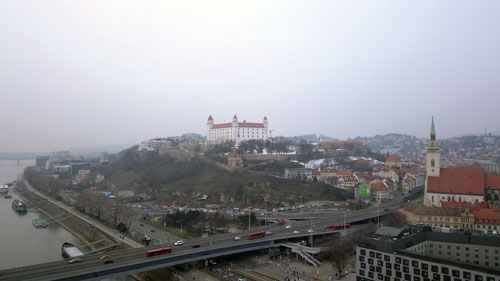 is also a concert hall in the castle. A copy of the Stefan Crown of the
Hungarian kings is on display in one of the castle towers. We drink a cup of
coffee in the cafe and then walk down the hill again. We pass by the St
Nicholas church and see the sculpture of the mythical figure Basorka by the
Slovakian sculptor Tibor Bárthfay. It is a young witch with broad drawn-out
hair, long legs and in the company of ravens.
is also a concert hall in the castle. A copy of the Stefan Crown of the
Hungarian kings is on display in one of the castle towers. We drink a cup of
coffee in the cafe and then walk down the hill again. We pass by the St
Nicholas church and see the sculpture of the mythical figure Basorka by the
Slovakian sculptor Tibor Bárthfay. It is a young witch with broad drawn-out
hair, long legs and in the company of ravens.
We have a rest in the hotel and have lunch in the hotel restaurant. At 2
pm we are picked up by our guide Peter, who guides us through the old town.
Peter knows a lot about almost every building in the old city. In this
old city there are many city palaces once owned by noble families and also a
large number of churches. A number of
 those
noble palaces had famous composers visiting during the course of time.
Mozart gave concerts here as a child and Van Beethoven and Liszt worked here
as a piano teacher. Bela Bartok went to the grammar school here. We start at
the Hvievdoslav Namieste, the square in front of the hotel. This was once a
side arm of the Danube, but has been filled under empress Maria Theresia. On
the square are a number of statues of poets, including Hvievdoslav, but also
HC Andersen, the Danish fairy tale writer, who once visited the city and
wrote about it positively. Then we pass the St Martin Cathedral and walk
past the Poor Clares Monastery with its 14th century church. The church
tower does not have its own foundation, but rests on a pillar of the north
façade. We walk to the St Michael cit gate, the only remaining city gate of
the city. The other city gates were demolished under the reign of Empress
Maria Theresa. The gate complex has two ports, which are at right angles to
each other. The goal was to lure attackers from the outside in and capture
them between the two gates. Outside the gate is a bridge over the former
city moat, which is flanked by statues of the archangel Michael and Saint
John Nepomuk, a very popular saint in the former Habsburg Empire. Back in
the city we pass the Franciscan monastery with church, the oldest church in
Bratislava. She was already consecrated in 1297. Next to it is the Jesuit
Church, which originally belonged to the Protestant congregation, but came
into the hands of Jesuits during the Counter Reformation. Then we arrive at
the main square, wher
those
noble palaces had famous composers visiting during the course of time.
Mozart gave concerts here as a child and Van Beethoven and Liszt worked here
as a piano teacher. Bela Bartok went to the grammar school here. We start at
the Hvievdoslav Namieste, the square in front of the hotel. This was once a
side arm of the Danube, but has been filled under empress Maria Theresia. On
the square are a number of statues of poets, including Hvievdoslav, but also
HC Andersen, the Danish fairy tale writer, who once visited the city and
wrote about it positively. Then we pass the St Martin Cathedral and walk
past the Poor Clares Monastery with its 14th century church. The church
tower does not have its own foundation, but rests on a pillar of the north
façade. We walk to the St Michael cit gate, the only remaining city gate of
the city. The other city gates were demolished under the reign of Empress
Maria Theresa. The gate complex has two ports, which are at right angles to
each other. The goal was to lure attackers from the outside in and capture
them between the two gates. Outside the gate is a bridge over the former
city moat, which is flanked by statues of the archangel Michael and Saint
John Nepomuk, a very popular saint in the former Habsburg Empire. Back in
the city we pass the Franciscan monastery with church, the oldest church in
Bratislava. She was already consecrated in 1297. Next to it is the Jesuit
Church, which originally belonged to the Protestant congregation, but came
into the hands of Jesuits during the Counter Reformation. Then we arrive at
the main square, wher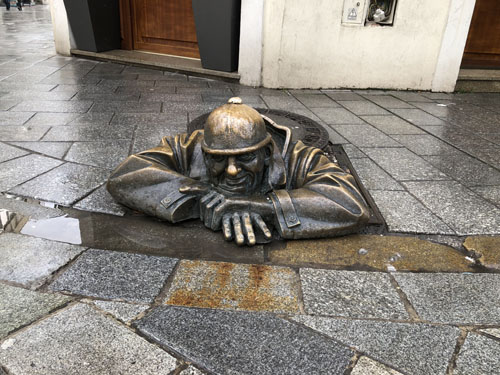 e
the old town hall is located. This is a amalgamation of civil and former
ecclesiastical buildings. On the square are a number of statues, which
mainly have a decorative value, yet very photogenic. Such as the statue of a
Napoleon-like figure, leaning on a bench in front of the French embassy and
that of Cumil, a sewer worker, who pops up out of a manhole. The statue in
front of the Mayer Tea Rooms was made after a real living person. Ignac
Lamar lived from 1897 to 1967 and was a well-known figure in Bratislava, who
took off his top hat for all the ladies and ordered a wedding cake from
Mayer's for the wedding that never came. We return to the Hvievdoslav
Namieste at the National Theater, where many operas are performed. These
also attract audiences from Vienna because of the considerably lower ticket
prices here. It was built in stone in the 19th century. Next to it is the
Philharmonic, which is next to our hotel. We say goodbye to Peter and warm
up in the room. It is pretty cold and because we have stood still a lot with
Peter for all those historic buildings have become somewhat hypothermic.
After the warm-up we cross the UFO bridge. This bridge from 1973 is
decorated with a UFO-shaped restaurant on top of the pylon, that carries the
bridge. We cool off again and return to the hotel.
e
the old town hall is located. This is a amalgamation of civil and former
ecclesiastical buildings. On the square are a number of statues, which
mainly have a decorative value, yet very photogenic. Such as the statue of a
Napoleon-like figure, leaning on a bench in front of the French embassy and
that of Cumil, a sewer worker, who pops up out of a manhole. The statue in
front of the Mayer Tea Rooms was made after a real living person. Ignac
Lamar lived from 1897 to 1967 and was a well-known figure in Bratislava, who
took off his top hat for all the ladies and ordered a wedding cake from
Mayer's for the wedding that never came. We return to the Hvievdoslav
Namieste at the National Theater, where many operas are performed. These
also attract audiences from Vienna because of the considerably lower ticket
prices here. It was built in stone in the 19th century. Next to it is the
Philharmonic, which is next to our hotel. We say goodbye to Peter and warm
up in the room. It is pretty cold and because we have stood still a lot with
Peter for all those historic buildings have become somewhat hypothermic.
After the warm-up we cross the UFO bridge. This bridge from 1973 is
decorated with a UFO-shaped restaurant on top of the pylon, that carries the
bridge. We cool off again and return to the hotel.
In the evening we eat at Modra Hviezda on the castle hill. It is a traditional Slovak restaurant. The service is friendly. The starters are simple. The main courses are more special. Erik takes pork schnitzel. Double folded on a potato pancake. The meat is unfortunately somewhat dry. This is also true for my wild boar sirloin on mashed potatoes. The Slovak cabernet sauvignon is good. As a dessert we take ice cream or a chocolate cake with almond - we adamantly disuaded from choosing the fruit cake. The reason why is not completely clear. We walk back to the hotel and drink coffee.
Weather: around freezing. Morning light snow. In the afternoon it brightens up and shines a faint sunshine
Saturday 24 February 2018
Bratislava - Nitra - Trnava - Bratislava
After breakfast we pick up the car from the car park and drive via the D1 highway to Nitra. In Nitra we drive the wrong way
for a bit, but quickly return to the right path. In the center we park the
car near the entrance of the castle hill. We first drink coffee. We take a
seat but find out that we are in the smoking room, which is almost as big as
the smoke-free room. So we just have to move. We walk uphill to the St
Emmeramus Cathedral on the castle hill. The church consists of three parts.
The upper part is the largest. Originally a Romanesque basilica, but later
richly decorated in baroque style. The lower church parts are much smaller
and more modest. We walk around the upper part of the castle hill and enjoy
the view over Nitra. We then walk down again and take a look at the lower
part of the castle hill with the grand seminar and the bishop's palace. On
the central square there is a huge statue of the Slavic prince Pribina (±
800-861) who had the first church built here. On the corner of the canons'
palace, a huge Atlas carries the palace on his shoulders. According to
legend, he was modelled afte a powerful blacksmith, who prevented the
Ottomans from conquering the city by throwing huge
the D1 highway to Nitra. In Nitra we drive the wrong way
for a bit, but quickly return to the right path. In the center we park the
car near the entrance of the castle hill. We first drink coffee. We take a
seat but find out that we are in the smoking room, which is almost as big as
the smoke-free room. So we just have to move. We walk uphill to the St
Emmeramus Cathedral on the castle hill. The church consists of three parts.
The upper part is the largest. Originally a Romanesque basilica, but later
richly decorated in baroque style. The lower church parts are much smaller
and more modest. We walk around the upper part of the castle hill and enjoy
the view over Nitra. We then walk down again and take a look at the lower
part of the castle hill with the grand seminar and the bishop's palace. On
the central square there is a huge statue of the Slavic prince Pribina (±
800-861) who had the first church built here. On the corner of the canons'
palace, a huge Atlas carries the palace on his shoulders. According to
legend, he was modelled afte a powerful blacksmith, who prevented the
Ottomans from conquering the city by throwing huge boulders at them. We walk back into the city and grab the car to drive to
the Kalvary Hill on the other side of town. It is a simple chapel dedicated
to the Assencion. Back in the center of Nitra we eat something in the modern
shopping center just outside the old center. A Slovak woman living in
Holland shows us the way to the restaurants in Dutch.
boulders at them. We walk back into the city and grab the car to drive to
the Kalvary Hill on the other side of town. It is a simple chapel dedicated
to the Assencion. Back in the center of Nitra we eat something in the modern
shopping center just outside the old center. A Slovak woman living in
Holland shows us the way to the restaurants in Dutch.
After lunch we drive to Trnava, halfway down the road to
Bratislava. This town is known as little Rome, because of the large number
of Catholic churches. We first drink coffee in a shop (Babovka)
at the Franciscan church St Jacobus. They have just opened shop three days
ago and are honored with the international visit. We even have to have our
picture taken with the owner. The church was closed. Afterwards we walk
across the trinity square along the city tower to the cathedral of St
Nicholas - which is just being opened up by the warden as we arrive - and
admire the rich baroque decoratio ns.
Frescoes with the prophets and evangelists decorate the ceiling. We go out
again, into the freezing cold and walk to the John the Baptist cathedral.
This was the first purely baroque church in Slovakia. The church was
consacrated in 1637. The church has a single nave and two towers. The
gigantic altar is from 1640. It measures up to 20 meters high and 14 wide.
One of the largest in Europe. Pope John Paul II visited the church in 2003.
There is a statue of him in front of the door.
ns.
Frescoes with the prophets and evangelists decorate the ceiling. We go out
again, into the freezing cold and walk to the John the Baptist cathedral.
This was the first purely baroque church in Slovakia. The church was
consacrated in 1637. The church has a single nave and two towers. The
gigantic altar is from 1640. It measures up to 20 meters high and 14 wide.
One of the largest in Europe. Pope John Paul II visited the church in 2003.
There is a statue of him in front of the door.
We drive back to Bratislava, where we arrive around 3.30pm. After a short
break we drink a cocktail in the Sky Bar, which, like our hotel, is located
on the Hviezdoslav. The view from the
Sky Bar is beautiful. You can see
the roofs of the old city, the castle and the St Martin Cathedral. There a re
some cute guys at the bar, the tables at the window are still free. We
both take a cocktail. I take a Bali Bali with coconut drink and Erik
something special with a cotton candy around the straw.
re
some cute guys at the bar, the tables at the window are still free. We
both take a cocktail. I take a Bali Bali with coconut drink and Erik
something special with a cotton candy around the straw.
After the cocktail we go via the hotel to the restaurant
Hradna Hviezda. The
restaurant is located on the castle hill and it is a steep climb to get
there. It is not crowded, but the food is OK. I take a carpaccio, followed
by a Deer medalion and Erik took grilled sheep cheese with basil
vinaigrette, followed by spiced petite mignons with potato pancakes
(harula). It tastes great, but it is filling. There is not much choice for a
dessert. We take the pastry and not the flanges. We drink a Slovak wine with
the meal. Slovak wines are not or hardly exported, but taste reasonably
good. After dinner we walk down the Castle Hill around the other side and
stop at
Teplaren, a small gay
café. It has a casual atmosphere and is mixed gay. We drink a Slovak beer,
Steiger. After the beer back to the
Hotel.
Weather: sunny and cold: -3 to -1 degrees.
Sunday 25 February 2018
After breakfast we walk through the bitter freezing cold to the Blue Church of Bratislava church or St Elisabeth Church. This church was built in
1908 after a design by a Hungarian architect in Jugendstil. There is a mass
in progress, which is well attended. We sit in on the last minutes of it.
After the last tones of the organ have sounded, the church crowd streams out
rapidly and we can take some pictures of the pastel blue Jugendstil
interior. We then walk to the center and drink coffee in a café. We continue
to the
Primate Palace. This was once the arch episcopal palace. During
the time that Hungary was largely occupied by the Turks in the 16th century,
the archbishop of Estergom settled here. After the Turks were expelled from
Hungary at the end of the 17th century, the archdiocese moved back to
Estergom. The palace was sold to the city. During a renovation in the early
20th century a number of very expensive gobelins , made in England in the
17th century, were discovered. A dispute arose between the bishop and the
city about the ownership. The quarrel ended with the donation of carpets to
the city, provided they were always publicly accessible. In addition to the
beautiful carpets, there is also the Mirror Hall, where on December 26, 1805
the Pressburg peace was signed after the battle of Austerlitz, which
Napoleon had won for France against the coalition of England, Austria and
Russia. There is also a window that looks into the Ladislaus chapel. A
service performed t
Church of Bratislava church or St Elisabeth Church. This church was built in
1908 after a design by a Hungarian architect in Jugendstil. There is a mass
in progress, which is well attended. We sit in on the last minutes of it.
After the last tones of the organ have sounded, the church crowd streams out
rapidly and we can take some pictures of the pastel blue Jugendstil
interior. We then walk to the center and drink coffee in a café. We continue
to the
Primate Palace. This was once the arch episcopal palace. During
the time that Hungary was largely occupied by the Turks in the 16th century,
the archbishop of Estergom settled here. After the Turks were expelled from
Hungary at the end of the 17th century, the archdiocese moved back to
Estergom. The palace was sold to the city. During a renovation in the early
20th century a number of very expensive gobelins , made in England in the
17th century, were discovered. A dispute arose between the bishop and the
city about the ownership. The quarrel ended with the donation of carpets to
the city, provided they were always publicly accessible. In addition to the
beautiful carpets, there is also the Mirror Hall, where on December 26, 1805
the Pressburg peace was signed after the battle of Austerlitz, which
Napoleon had won for France against the coalition of England, Austria and
Russia. There is also a window that looks into the Ladislaus chapel. A
service performed t here
too. The building has been designed in a classicist style by a Viennese
architect and has a striking pink façade, crowned by a gigantic cardinal's
hat. Now it is, next to being a museum, the seat of the city council.
here
too. The building has been designed in a classicist style by a Viennese
architect and has a striking pink façade, crowned by a gigantic cardinal's
hat. Now it is, next to being a museum, the seat of the city council.
We pick up the car and drive out of town to
Danubiana – Meulensteen Art Museum..
It is about half an hour's drive. This museum is located on an island in the
Danube on the border with Hungary and was founded by the Dutch industrialist
Gerard Meulensteen. It has a collection of modern and contemporary art,
mainly from Slovak artists. However, there are also a number of works by
Dutch modernists Karel Appel and Corneille, Spanish Miro and
Hungaro-American Gabo. The museum is beautifully situated on the waterfront
and the sculpture garden is beautifully interwoven with the museum itself.
There are also two temporary exhibitions by Francesa Marti and photographer
Robert Vano.
We eat in the museum café and then drive back into the city to the
monument for the fallen soldiers of the Red Army. Here the 7000 soldiers are
commemorated, who lost their lives during the lib eration
of Slovakia from the Nazis. That this liberation again started a new
occupation is not mentioned. The monument is located on top of a hill and
commands a great view of the city. On top of the column is sculpture of
a militant soldier flying a banner. In the garden there is memorial tile for
Alexander Dubcek, the man who wanted to give socialism a human face during
the Prague spring of 1968, which could find no mercy in the eyes of the
Kremlin in Moscow . Dubcek was deposed by troops of the Warsaw Pact, spent
his days as a caretaker of residential block, until he reappeared during the
Velvet Revolution of 1989 and became chairman of the federal parliament of
Czechoslovakia. He died in 1997.
eration
of Slovakia from the Nazis. That this liberation again started a new
occupation is not mentioned. The monument is located on top of a hill and
commands a great view of the city. On top of the column is sculpture of
a militant soldier flying a banner. In the garden there is memorial tile for
Alexander Dubcek, the man who wanted to give socialism a human face during
the Prague spring of 1968, which could find no mercy in the eyes of the
Kremlin in Moscow . Dubcek was deposed by troops of the Warsaw Pact, spent
his days as a caretaker of residential block, until he reappeared during the
Velvet Revolution of 1989 and became chairman of the federal parliament of
Czechoslovakia. He died in 1997.
We drive back to the hotel and drink
another coffee and cake at
Konditorei Mayer tea
rooms, on the main square. Around half past five we pack the suitcases and
drive to Schwechat, the airport of Vienna. We return the car at Sixt and
walk to departure hall 1A, where we want to drop off our suitcase. Hall 1A
is a separate annexe of hall 1. When we enter it is completely deserted. We
are too early. The desk will not open until two hours before
departure. There are not many eateries before security checks. We have to
settle for the Burger King. After the burger we can drop off our suitcase
and go through the check. There we find an huge shopping area store
and food emporium, but we are already filled. Then wait patiently for our
flight with a cup of coffee in hand. The flight by Transavia has been
delayed due to delays earlier that day and we depart around 1 hour late at
21.20. The flight goes smoothly and around 11pm we arrive in Rotterdam.
Weather: sunny and cold: -9 degrees
read More Travel stories
